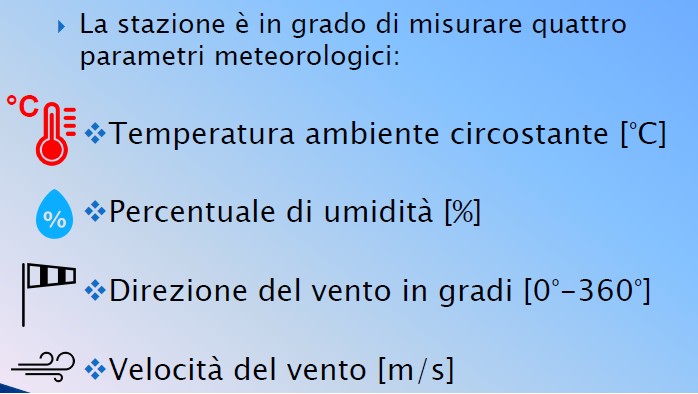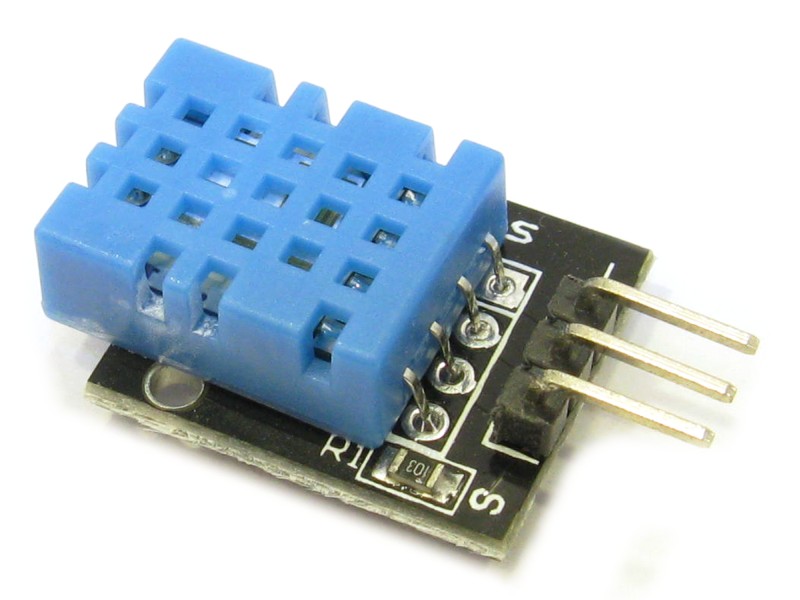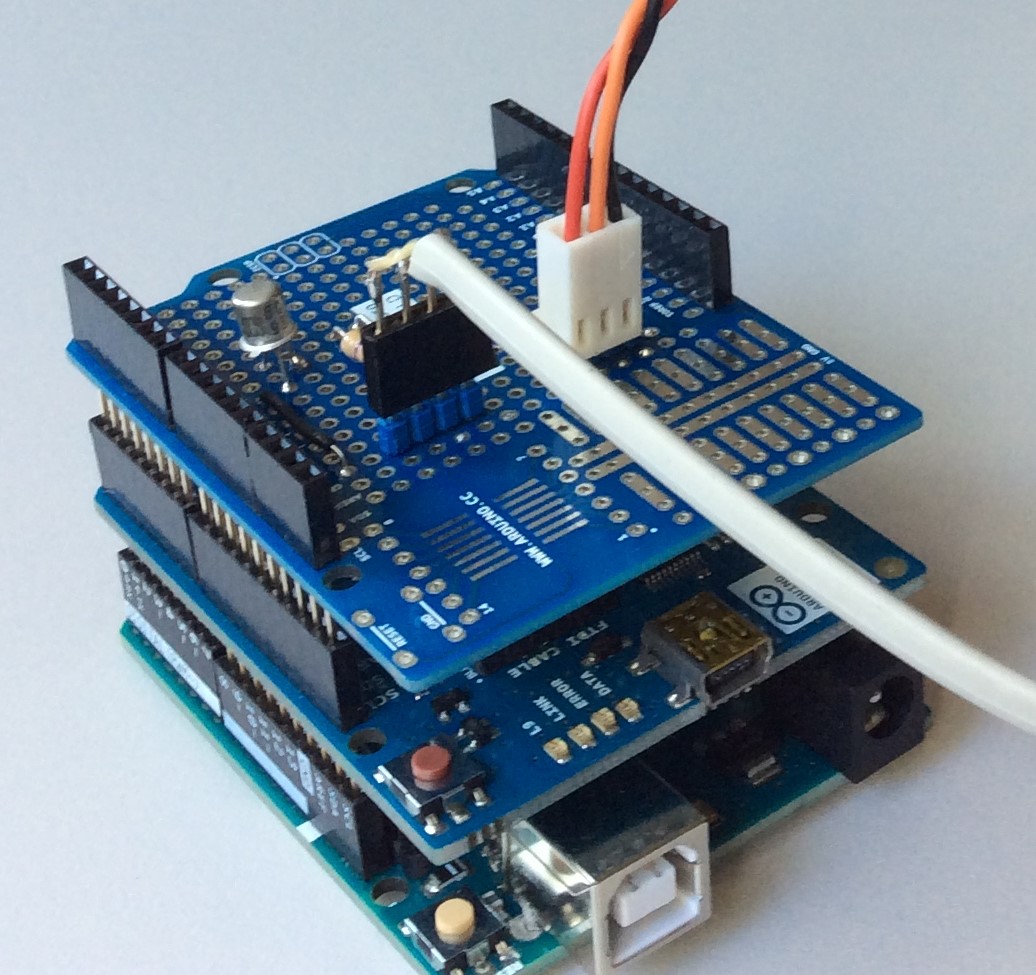In questo articolo vedremo come realizzare una semplice stazione meteo con Arduino.
Il progetto è stato presentato come tesina all'esame di maturità a.s. 2017/18 dallo studente di Informatica Alex Toto dell' ITI E. Majorana di Grugliasco (TO)
I dati acquisiti ogni 5 sec. dai sensori mediante una scheda Arduino Uno verranno inviata ad un web server dove uno script PHP provvederà a memorizzarli su un database MySQL.
Una pagina WEB permetterà poi di visualizzare sul browser sia i dati in tempo reale che lo storico delle acquisizioni.

Il sistema è composto da:
- Un sensore di temperatura e umidità digitale tipo DHT11

- Un sensore di velocità e direzione del vento: Anemometro WS2300-15 (img + scheda dati)
- Una scheda Arduino Uno rev. 3
- Una shield WiFi Arduino (per connessione Internet a web server)
- Una scheda custom per circuiti necessari all' Anemometro, al DHT11 e connettori vari.
- Un Server web con PHP e MySQL (sito gratuito su altervista.org)

Le tre schede del sistema impilate: la scheda custom, lo shield WiFi, Arduino Uno

Particolare della scheda custom
Il codice per Arduino ottenuto modificando il programma "Repeating Wifi Web Client" che si trova negli esempi della WiFi:
/* Repeating Wifi Web Client This sketch connects to a a web server and makes a request using an Arduino Wifi shield. Circuit: * WiFi shield attached to pins SPI pins and pin 7 created 23 April 2012 modified 31 May 2012 by Tom Igoe modified 13 Jan 2014 by Federico Vanzati http://www.arduino.cc/en/Tutorial/WifiWebClientRepeating This code is in the public domain. */ /* Modificato il 25/05/2018 per progetto STAZIONE METEO * by TOTO Alex e MAIDA Vincenzo */ #include <SPI.h> #include <WiFi.h> //Impostazioni per sensore di Umidità/Temperatura DHT11 #include <DHT.h> #define DHTPIN 5 // 5 è il pin di Arduino a cui collego il sensore DHT11 (porta OUT, ossia la porta dati) #define DHTTYPE DHT11 // dht11 è il tipo di sensore utilizzato DHT dht(DHTPIN, DHTTYPE); //Anemometro SW2003-15 int pinTX = 6; int pinEN = 8; //DHT11 int pinData = 5; //Variabili per meteo int dati[30]; //Vettore per acquisizione di 30 campioni da Anemometro float vv=20.2; //Velocità vento in m/s int dv=180; //Direzione vento in Gradi float t=28.5; //Temperatura in °C int u=70; //Umidità in % String query="GET /salva_meteo1.php?vv="+String(vv,DEC)+"&dv="+String(dv,DEC)+"&t="+String(t,DEC)+"&u="+String(u,DEC)+" HTTP/1.1"; char ssid[] = "AndroidAP"; // your network SSID (name) char pass[] = "prova2018"; // your network password int keyIndex = 0; // your network key Index number (needed only for WEP) int status = WL_IDLE_STATUS; // Initialize the Wifi client library WiFiClient client; // server address: char server[] = "itismajo.altervista.org"; //IPAddress server(64,131,82,241); unsigned long lastConnectionTime = 0; // last time you connected to the server, in milliseconds const unsigned long postingInterval = 10L * 1000L; // delay between updates, in milliseconds. void setup() { pinMode(pinData,INPUT); pinMode(pinTX,INPUT); pinMode(pinEN,OUTPUT); digitalWrite(pinEN,LOW); //Initialize serial and wait for port to open: Serial.begin(9600); while (!Serial) { ; // wait for serial port to connect. Needed for native USB port only } // check for the presence of the shield: if (WiFi.status() == WL_NO_SHIELD) { Serial.println("WiFi shield not present"); // don't continue: while (true); } String fv = WiFi.firmwareVersion(); if (fv != "1.1.0") { Serial.println("Please upgrade the firmware"); } // attempt to connect to Wifi network: while (status != WL_CONNECTED) { Serial.print("Attempting to connect to SSID: "); Serial.println(ssid); // Connect to WPA/WPA2 network. Change this line if using open or WEP network: status = WiFi.begin(ssid, pass); // wait 10 seconds for connection: delay(10000); } // you're connected now, so print out the status: printWifiStatus(); } void loop() { // if there's incoming data from the net connection. // send it out the serial port. This is for debugging // purposes only: while (client.available()) { char c = client.read(); Serial.write(c); } // if ten seconds have passed since your last connection, // then connect again and send data: if (millis() - lastConnectionTime > postingInterval) { httpRequest(); } } /******************************* * *** INIZIO SOTTOPROGRAMMI *** ******************************/ // this method makes a HTTP connection to the server: void httpRequest() { // close any connection before send a new request. // This will free the socket on the WiFi shield client.stop(); // if there's a successful connection: if (client.connect(server, 80)) { acquisizioneDati(); query="GET /salva_meteo1.php?vv="+String(vv,DEC)+"&dv="+String(dv,DEC)+"&t="+String(t,DEC)+"&u="+String(u,DEC)+" HTTP/1.1"; stampa(); // send the HTTP PUT request: //client.println("GET /latest.txt HTTP/1.1"); client.println(query); client.println("Host: itismajo.altervista.org"); client.println("User-Agent: ArduinoWiFi/1.1"); client.println("Connection: close"); client.println(); // note the time that the connection was made: lastConnectionTime = millis(); } else { // if you couldn't make a connection: Serial.println("connection failed"); } } void printWifiStatus() { // print the SSID of the network you're attached to: Serial.print("SSID: "); Serial.println(WiFi.SSID()); // print your WiFi shield's IP address: IPAddress ip = WiFi.localIP(); Serial.print("IP Address: "); Serial.println(ip); // print the received signal strength: long rssi = WiFi.RSSI(); Serial.print("signal strength (RSSI):"); Serial.print(rssi); Serial.println(" dBm"); } void acquisizioneDati(){ int i; //Acquisizione dati anemometro digitalWrite(pinEN,LOW); while(digitalRead(pinTX)==HIGH){ //Attendi } delayMicroseconds(625); for(i=0; i<30; i++){ dati[i]=digitalRead(pinTX); delayMicroseconds(1250); } digitalWrite(pinEN,HIGH); dv=bintodec(5,8) * 22.5; //Convertito in gradi vv=bintodec(9,20) * 0.1; //Convertito in m/s //DHT11 t = dht.readTemperature(); u = dht.readHumidity(); } int bintodec(int inizio,int fine){ int i=0; int d=0; //numero in decimale int e=1; //equivale a 2^0 for(i=inizio;i<=fine; i++){ d=d+dati[i]*e; e=e*2; } return d; } void stampa(){ int i; //Dati anemometro Serial.println("Acquisizione dati Anemometro"); Serial.println("Direzione Vento (4 bit) indice da 5 a 8 dove 5=LSB e 8=MSB. Dato binario da leggere da destra verso sinistra:"); for(i=5;i<=8;i++){ Serial.print(dati[i]); Serial.print(" "); } //Serial.println(); Serial.print(" = "); Serial.print(bintodec(5,8)); Serial.print(" DEC in gradi--> "); Serial.println(bintodec(5,8)*22.5); Serial.println("Velocità Vento (12 bit) indice da 9 a 20 dove 9=LSB e 12=MSB. Dato binario da leggere da destra verso sinistra:"); for(i=9;i<=20;i++){ Serial.print(dati[i]); Serial.print(" "); } Serial.print(" = "); Serial.print(bintodec(9,20)); Serial.print(" DEC in m/s--> "); Serial.println(bintodec(9,20)*0.1); //Dati DHT11 Serial.println("Acquisizione dati DHT11"); Serial.print("Temperatura [°C]: "); Serial.print(t); Serial.println("°C"); //delay(1000); Serial.print("Umidita' [%]: "); Serial.print(u); Serial.println("%"); //Invio Dati al server Serial.println("connecting..."); Serial.print("query= "); Serial.println(query); }
Il database MySQL (my_itismajo) contiene due tabelle: meteo e meteo_real_time
La tabella METEO è così organizzata:
| # | Nome | Tipo | Codifica caratteri | Attributi | Null | Predefinito | Commenti | Extra |
|---|---|---|---|---|---|---|---|---|
| 1 | int(11) | No | Nessuno | AUTO_INCREMENT | ||||
| 2 | timestamp | No | CURRENT_TIMESTAMP | |||||
| 3 | float | No | Nessuno | in m/s | ||||
| 4 | int(11) | No | Nessuno | in gradi da 0 a 360 | ||||
| 5 | float | No | Nessuno | [°C] | ||||
| 6 | int(11) | No | 0 |
La tabella METEO_REAL_TIME ha identica struttura ma conterrà un solo record e verrà aggiornato da Arduino ogni 5 secondi.
Lo script PHP "salva_meteo1.php" chiamato da Arduino sul server all'indirizzo itismajo.altervista.org si occupa di aggiornare le due tabelle.
Ogni 5 secondi aggiorna la tabella METEO_REAL_TIME (update) ed ogni 10 minuti aggiunge un nuovo record alla tabella METEO (insert)
<?php
/* * ****************************************************************
* Salva_meteo1.php
* 1. Riceve dati meteo ogni 5 secondi e li memorizza (update) nel record 1 della tabella METEO_REAL_TIME
* 2. Controlla la data dell'ultimo dato meteo inserito nella tabella METEO e se c'è una differenza >= a 10 minuti
* col dato in tempo reale aggiunge quest'ultimo come nuovo record alla tabella METEO (storico)
*/
function getData($tabella){
$mysqli = @new mysqli("localhost", "root", "", "my_itismajo");
if ($mysqli->connect_errno) {
die( "Errore di connessione a MySQL: (" . $mysqli->connect_errno . ") " . $mysqli->connect_error);
}
$sql = "SELECT data FROM $tabella ORDER BY id DESC LIMIT 1";
$result = $mysqli->query($sql);
if (!$result) {
die('Query Errata: ' .$mysqli->error);
}
$row = $result->fetch_array(MYSQLI_ASSOC);
return $row['data'];
}
function update() {
//1. Recupera dati dal form
$velocita_vento = $_GET["vv"];
$direzione_vento = $_GET["dv"];
$temperatura = $_GET["t"];
$umidita = $_GET["u"];
//Validazione dati (VUOTO)
//Inserimento dati nel database: tabella meteo
//Connessione al database
$mysqli = @new mysqli("localhost", "root", "", "my_itismajo");
if ($mysqli->connect_errno) {
die( "Errore di connessione a MySQL: (" . $mysqli->connect_errno . ") " . $mysqli->connect_error);
}
$data= date("Y-m-d H:i:s");
$sql = "UPDATE meteo_real_time SET data='$data', velocita_vento = $velocita_vento, direzione_vento=$direzione_vento, temperatura = $temperatura, umidita = $umidita WHERE id=1";
$result = $mysqli->query($sql);
if (!$result) {
die('Query Errata: ' .$mysqli->error);
}
If ($result == false) {
print "<h1>Errore inserimento dati meteo nella query $sql -" . $mysqli->error . "</h1>\n";
//print "<a href=\"javascript:history.back()\">Ritorna al form.</a>";
exit;
} else
return "<h2>Dati REAL TIME aggiornati correttamente.</h2>";
} //Fine UPDATE
function insert(){
//1. Recupera dati dal form
$velocita_vento = $_GET["vv"];
$direzione_vento = $_GET["dv"];
$temperatura = $_GET["t"];
$umidita = $_GET["u"];
//Validazione dati (VUOTO)
//Inserimento dati nel database: tabella meteo
//Connessione al database
$mysqli = @new mysqli("localhost", "root", "", "my_itismajo");
if ($mysqli->connect_errno) {
die( "Errore di connessione a MySQL: (" . $mysqli->connect_errno . ") " . $mysqli->connect_error);
}
$sql="INSERT INTO meteo(velocita_vento, direzione_vento,temperatura,umidita) VALUES ($velocita_vento,$direzione_vento,$temperatura,$umidita)";
$result = $mysqli->query($sql);
if (!$result) {
die('Query Errata: ' .$mysqli->error);
}
If ($result == false) {
print "<h1>Errore inserimento dati meteo nella query $sql -" . $mysqli->error . "</h1>\n";
//print "<a href=\"javascript:history.back()\">Ritorna al form.</a>";
exit;
} else
return "<h2>Dati METEO STORICO inseriti correttamente.</h2>";
}
//**** MAIN ********
$msg = new stdClass();
//$myObj->localTime = 5;
//$msg="";
$msg->update=update();
$data1=getData("meteo");
$data1sec= strtotime($data1);
//var_dump($data1);
$msg->storico="-Data Storico: ".$data1;
$data2=getData("meteo_real_time");
$data2sec= strtotime($data2);
$msg->dataRT="-Data Real Time: ".$data2;
$msg->differenza="Differenza in sec.: ".($data2sec-$data1sec);
if (($data2sec-$data1sec)>=(10*60)){
$msg->insert= insert();
}
//print $msg;
$myJSON = json_encode($msg);
echo $myJSON;
?>
Per visualizzare i dati presenti nel database la pagina da chiamare è : http://itismajo.altervista.org/meteo1.php

Lo script visualizza sia l'ultimo dato in tempo reale (prelevandolo dalla tabella METEO_REAL_TIME) che lo storico di tutti i dati memorizzati nella tabella METEO.
Il codice della pagina meteo1.php
<?php
include "config.php"; //Dati di connessione al database
$sql = "SELECT * FROM meteo ORDER BY id DESC";
$result = $mysqli->query($sql);
If ($result == false) {
print "<h1>Errore inserimento dati meteo nella query $sql -" . $mysqli->error . "</h1>\n";
//print "<a href=\"javascript:history.back()\">Ritorna al form.</a>";
exit;
}
$html="";
while ($row = $result->fetch_array(MYSQLI_ASSOC)) {
$html.="<tr><td class='text-center'>".implode("</td><td class='text-center'>", $row)."</td></tr>\n";
}
?>
<!DOCTYPE html>
<html lang="en">
<head>
<title>Stazione Meteo</title>
<meta charset="utf-8">
<meta name="viewport" content="width=device-width, initial-scale=1">
<!-- Latest compiled and minified CSS -->
<link rel="stylesheet" href="https://maxcdn.bootstrapcdn.com/bootstrap/3.3.7/css/bootstrap.min.css">
<!-- jQuery library -->
<script src="https://ajax.googleapis.com/ajax/libs/jquery/3.3.1/jquery.min.js"></script>
<!-- Latest compiled JavaScript -->
<script src="https://maxcdn.bootstrapcdn.com/bootstrap/3.3.7/js/bootstrap.min.js"></script>
</head>
<body>
<div class="container">
<h2>Stazione Meteo con Arduino UNO</h2>
<p>Area di progetto di Toto Alex - 5Binfo - A.S. 2017/18</p>
<h2>Dati aggiornati in tempo reale al <strong id="dataRT"></strong></h2>
<p> </p>
<table class="table table-hover">
<thead>
<tr>
<th class="text-center"><strong id="pb_1" class="h1"></strong><img src="https://encrypted-tbn0.gstatic.com/images?q=tbn:ANd9GcQqOZ3D82xYp0_8ykoaZAWGJPUTwxUJs8O44s7N_QUW3Q0WZBxT" width="60" height="60"></th>
<th class="text-center"><strong id="pb_2" class="h1"></strong><img src="https://image.flaticon.com/icons/png/128/55/55971.png" width="60" height="60"></th>
<th class="text-center"><strong id="pb_3" class="h1"></strong><img src="https://www.dolomiti.it/fileadmin/meteo/meteo_icone/temperatura.png" width="60" height="60"></th>
<th class="text-center"><strong id="pb_4" class="h1"></strong><img src="https://cdn4.iconfinder.com/data/icons/the-weather-is-nice-today/64/weather_44-128.png" width="60" height="60"></th>
</tr>
</thead>
<tbody>
<tr>
<th class="text-center">Velocità vento [m/s]</th>
<th class="text-center">Direzione vento (0°-360°) [Gradi]</th>
<th class="text-center">Temperatura ambiente [°C]</th>
<th class="text-center">Umidità ambiente [%]</th>
</tr>
</tbody>
</table>
<h2>Storico dati meteo</h2>
<table class="table table-hover">
<thead>
<tr>
<th class="text-center">id</th>
<th class="text-center">Data</th>
<th class="text-center">Velocità vento [m/s]</th>
<th class="text-center">Direzione vento (0°-360°) [Gradi]</th>
<th class="text-center">Temperatura ambiente [°C]</th>
<th class="text-center">Umidità ambiente [%]</th>
</tr>
</thead>
<tbody>
<?php print $html; ?>
</tbody>
</table>
</div>
<script src="https://ajax.googleapis.com/ajax/libs/jquery/3.3.1/jquery.min.js"></script>
<script>
change();
var myVar = setInterval(change, 10000);
// var myVar1 = setInterval(location.reload(true), 60*10);
var perc = 0;
function change() {
//todo
perc += 10;
if (perc >= 620){
perc = 0;
location.reload(true);
}
$.get("legge_meteo_real_time.php",
{
},
function(data,status){
var obj=JSON.parse(data);
$('#pb_1').html(obj.vv+" ");
$('#pb_2').html(obj.dv+" ");
$('#pb_3').html(obj.t+" ");
$('#pb_4').html(obj.u+" ");
$('#dataRT').html(obj.dataRT);
/*alert("status: " + status +
"\ndata: " + data
); */
});
//$('#pb_1').css('width', perc + '%');
$('#pb_1').html(perc + '%');
}
</script>
</body>
</html>
Lo script legge_meteo_real_time.php richiamato dalla pagina web mediante funzione JQuery $.get() per aggiornamento automatico dei dati reali ogni 10 secondi
<?php
include "config.php"; //Dati di connessione al database
$sql = "SELECT * FROM meteo_real_time";
$result = $mysqli->query($sql);
If ($result == false) {
print "<h1>Errore inserimento dati meteo nella query $sql -" . $mysqli->error . "</h1>\n";
//print "<a href=\"javascript:history.back()\">Ritorna al form.</a>";
exit;
}
$msg = new stdClass();
$row = $result->fetch_array(MYSQLI_ASSOC);
$msg->vv=$row["velocita_vento"];
$msg->dv=$row["direzione_vento"];
$msg->t=$row["temperatura"];
$msg->u=$row["umidita"];
$msg->dataRT=$row["data"];
$myJSON = json_encode($msg);
echo $myJSON;
?>
Link utili e documentazione:
- Scheda custom (elenco componenti e foto per realizzazione)
- Documentazione Anemometro WS2300-15 e TX20 (molto simile al WS2300-15 ma con documentazione migliore! )




